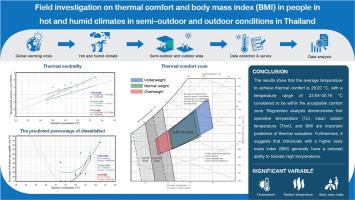Assessing thermal comfort in hot and humid (tropical) climates: Urban outdoor and semi-outdoor conditions in waiting areas of railway stations
IF 7.1
1区 工程技术
Q1 CONSTRUCTION & BUILDING TECHNOLOGY
引用次数: 0
Abstract
The global phenomenon of global warming has intensified thermal discomfort in tropical metropolitan areas, where rising temperatures and the urban heat island significantly impact outdoor and semi-outdoor environments. These effects are particularly pronounced in tropical metropolitan areas, where the hot and humid climate exacerbates thermal stress. Despite the critical need to understand thermal comfort in such settings, existing research remains limited. This study addresses the research gap by examining how global warming affects thermal comfort in outdoor and semi-outdoor urban spaces, providing insights into the unique challenges these environments present. The study sought to assess both objective physical data and subjective Thermal Sensation Votes (TSV) and preferences. The results suggest that the temperature neutrality needed for thermal comfort is 29.02 °C (R2 = 0.95), and a temperature comfortable range of 23.84–30.79 °C (R2 = 0.84) is within the acceptable comfort level. This range surpasses the current averages, emphasizing the importance of environmental enhancements for better thermal comfort. The regression analysis indicates that operational temperature (To), mean radiant temperature (Tmrt), and body mass index (BMI) are significant variables that may accurately predict thermal sensation. Furthermore, results indicate that individuals with a higher BMI often have a reduced ability to withstand elevated temperatures. This study emphasizes the need of considering both environmental and human factors in order to improve the human comfort level and quality of life.

评估湿热(热带)气候下的热舒适度:火车站候车区的城市室外和半室外条件
全球变暖现象加剧了热带都市地区的热不适感,气温上升和城市热岛对室外和半室外环境造成了严重影响。这些影响在热带都市地区尤为明显,湿热的气候加剧了热压力。尽管亟需了解这种环境下的热舒适性,但现有研究仍然有限。本研究通过考察全球变暖如何影响室外和半室外城市空间的热舒适度来填补这一研究空白,从而深入了解这些环境所带来的独特挑战。该研究试图评估客观物理数据和主观热感值(TSV)及偏好。结果表明,热舒适度所需的中性温度为 29.02 °C(R2 = 0.95),23.84-30.79 °C(R2 = 0.84)的舒适温度范围属于可接受的舒适度范围。这一范围超过了目前的平均水平,强调了改善环境以提高热舒适度的重要性。回归分析表明,工作温度(To)、平均辐射温度(Tmrt)和体重指数(BMI)是可以准确预测热感觉的重要变量。此外,研究结果表明,体重指数越高的人承受高温的能力往往越弱。这项研究强调,为了提高人类的舒适度和生活质量,需要同时考虑环境因素和人为因素。
本文章由计算机程序翻译,如有差异,请以英文原文为准。
求助全文
约1分钟内获得全文
求助全文
来源期刊

Building and Environment
工程技术-工程:环境
CiteScore
12.50
自引率
23.00%
发文量
1130
审稿时长
27 days
期刊介绍:
Building and Environment, an international journal, is dedicated to publishing original research papers, comprehensive review articles, editorials, and short communications in the fields of building science, urban physics, and human interaction with the indoor and outdoor built environment. The journal emphasizes innovative technologies and knowledge verified through measurement and analysis. It covers environmental performance across various spatial scales, from cities and communities to buildings and systems, fostering collaborative, multi-disciplinary research with broader significance.
 求助内容:
求助内容: 应助结果提醒方式:
应助结果提醒方式:


